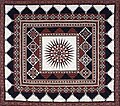
Patchwork quilts are made with patterns, many of which are common designs in North America.
Contents
- Anvil [1]
- Basket [1]
- Bear Paw [1]
- Brick Work [2]
- Churn Dash [1]
- Corn and Beans [1]
- Dogwood and Sunflower [1]
- Double Wedding Ring [1]
- Dove in the Window [1]
- Dresden Plate [1]
- Drunkard's Path [1]
- Eight-Pointed Star [1]
- Four Patch [2]
- Hen and Chickens [1]
- God's Eye [1]
- Grandmother's Flower Garden [1]
- Kansas Star (also called Kansas City Star, after the newspaper that published them) [3]
- Liberty Star Block [1]
- Lincoln Platform [1]
- Log Cabin [1]
- Nebraska Pinwheel [1]
- Nebraska State Block [1]
- Nine Patch [1] [2]
- Pinwheel [1]
- Roman Square [2]
- Roman Stripe [2]
- Rose of Sharon, or Whig Rose [1]
- School House [1]
- Sunbonnet Babies [1] [2]
- Tumbling Blocks [2]
- Wild Goose Chase [1]

